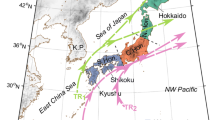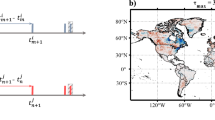Abstract
The South American Andes are frequently exposed to intense rainfall events with varying moisture sources and precipitation-forming processes. In this study, we assess the spatiotemporal characteristics and geographical origins of rainfall over the South American continent. Using high-spatiotemporal resolution satellite data (TRMM 3B42 V7), we define four different types of rainfall events based on their (1) high magnitude, (2) long temporal extent, (3) large spatial extent, and (4) high magnitude, long temporal and large spatial extent combined. In a first step, we analyze the spatiotemporal characteristics of these events over the entire South American continent and integrate their impact for the main Andean hydrologic catchments. Our results indicate that events of type 1 make the overall highest contributions to total seasonal rainfall (up to \(50\,\%\)). However, each consecutive episode of the infrequent events of type 4 still accounts for up to \(20\,\%\) of total seasonal rainfall in the subtropical Argentinean plains. In a second step, we employ complex network theory to unravel possibly non-linear and long-ranged climatic linkages for these four event types on the high-elevation Altiplano-Puna Plateau as well as in the main river catchments along the foothills of the Andes. Our results suggest that one to two particularly large squall lines per season, originating from northern Brazil, indirectly trigger large, long-lasting thunderstorms on the Altiplano Plateau. In general, we observe that extreme rainfall in the catchments north of approximately \(20^{\circ }\)S typically originates from the Amazon Basin, while extreme rainfall at the eastern Andean foothills south of \(20^{\circ }\)S and the Puna Plateau originates from southeastern South America.










Similar content being viewed by others
References
Anabor V, Stensrud DJ, de Moraes OLL (2008) Serial upstream-propagating mesoscale convective system events over southeastern South America. Mon Weather Rev 136(8):3087–3105. doi:10.1175/2007MWR2334.1
Barros VR, Clarke R, Silva Días P (2006) Climate Change in the La Plata Basin. Consejo Nacional de Investigaciones Científicas y Técnicas
Berezin Y, Gozolchiani A, Guez O, Havlin S (2012) Stability of climate networks with time. Sci Rep 2:1–8
Boers N, Bookhagen B, Marwan N, Kurths J, Marengo J (2013) Complex networks identify spatial patterns of extreme rainfall events of the South American Monsoon System. Geophys Res Lett 40(16):4386–4392. doi:10.1002/grl.50681
Boers N, Bookhagen B, Barbosa HMJ, Marwan N, Kurths J, Marengo J (2014a) Prediction of extreme floods in the eastern central andes based on a complex network approach. Nat Commun 5:5199. doi:10.1038/ncomms6199
Boers N, Donner RV, Bookhagen B, Kurths J (2014b) Complex network analysis helps to identify impacts of the El Niño Southern Oscillation on moisture divergence in South America. Clim Dyn. doi:10.1007/s00382-014-2265-7
Boers N, Rheinwalt A, Bookhagen B, Barbosa HMJ, Marwan N, Marengo JA, Kurths J (2014c) The South American rainfall dipole: a complex network analysis of extreme events. Geophys Res Lett 41(20):1944–8007. doi:10.1002/2014GL061829
Boers N, Bookhagen B, Marengo J, Marwan N, v Sorch JS, Kurths J (2015) Extreme rainfall of the South American monsoon system: a dataset comparison using complex networks. J Clim 28(3):1031–1056. doi:10.1175/JCLI-D-14-00340.1
Bookhagen B, Strecker MR (2008) Orographic barriers, high-resolution TRMM rainfall, and relief variations along the eastern Andes. Geophys Res Lett 35(6):L06,403
Bookhagen B, Strecker MR (2012) Spatiotemporal trends in erosion rates across a pronounced rainfall gradient: examples from the southern Central Andes. Earth Planet Sci Lett 327–328:97–110. doi:10.1016/j.epsl.2012.02.005
Carvalho LMV, Jones C, Posadas AND, Quiroz R, Bookhagen B, Liebmann B (2012) Precipitation characteristics of the South American monsoon system derived from multiple datasets. J Clim 25(13):4600–4620. doi:10.1175/JCLI-D-11-00335.1
Chen S, Hong Y, Gourley JJ, Huffman GJ, Tian Y, Cao Q, Yong B, Kirstetter PE, Hu J, Hardy J, Li Z, Khan SI, Xue X (2013) Evaluation of the successive V6 and V7 TRMM multisatellite precipitation analysis over the Continental United States. Water Resourc Res 49(12):8174–8186. doi:10.1002/2012WR012795
Cohen JCP, Silva Dias MAFS, Nobre CA (1995) Environmental conditions associated with Amazonian Squall Lines: a case study. Mon Weather Rev 123(11):3163–3174
Donges JF, Zou Y, Marwan N, Kurths J (2009) The backbone of the climate network. Europhys Lett 87(4):48,007
Durkee JD, Mote TL (2009a) A climatology of warm-season mesoscale convective complexes in subtropical South America. Int J Climatol. doi:10.1002/joc.1893
Durkee JD, Mote TL (2009b) A climatology of warm-season mesoscale convective complexes in subtropical South America. Int J Climatol 30(3):418–431
Durkee JD, Mote TL (2009c) A climatology of warm?season mesoscale convective complexes in subtropical South America. Int J Climatol 30(3):418–431. doi:10.1002/joc
Durkee JD, Mote TL, Shepherd JM (2009) The contribution of mesoscale convective complexes to rainfall across subtropical South America. J Clim 22(17):4590–4605. doi:10.1175/2009JCLI2858.1
Farr TG, Rosen PA, Caro E, Crippen R, Duren R, Hensley S, Kobrick M, Paller M, Rodriguez E, Roth L, Seal D, Shaffer S, Shimada J, Umland J, Werner M, Oskin M, Burbank D, Alsdorf DE (2007) The shuttle radar topography mission. Rev Geophys 45(2). doi:10.1029/2005RG000183
Garreaud RD (2000) Cold air incursions over subtropical South America: mean structure and dynamics. Mon Weather Rev 128(7):2544–2559. doi:10.1175/1520-0493(2000)128<2544:CAIOSS>2.0.CO;2
Garreaud RD (2009) The Andes climate and weather. Adv Geosci 22:1–9. doi:10.5194/adgeo-22-3-2009
Garreaud RD, Aceituno P (2001) Interannual rainfall variability over the South American Altiplano. J Clim 14(12):2779–2789
Garreaud RD, Wallace JM (1998) Summertime incursions of midlatitude air into subtropical and tropical South America. Mon Weather Rev 126(10):2713–2733. doi:10.1175/1520-0493(1998)126<2713:SIOMAI>2.0.CO;2
Garreaud RD, Vuille M, Clement AC (2003) The climate of the Altiplano: observed current conditions and mechanisms of past changes. Palaeogeogr Palaeoclimatol Palaeoecol 194(1):5–22
Griffiths PG, Magirl CS, Webb RH, Pytlak E, Troch Pa, Lyon SW (2009) Spatial distribution and frequency of precipitation during an extreme event: July 2006 mesoscale convective complexes and floods in southeastern Arizona. Water Resourc Res 45(7):W07,419. doi:10.1029/2008WR007380
Grimm AM, Tedeschi RG (2009) ENSO and extreme rainfall events in South America. J Clim 22(7):1589–1609. doi:10.1175/2008JCLI2429.1
Harden CP (2006) Human impacts on headwater fluvial systems in the northern and central Andes. Geomorphology 79:249–263. doi:10.1016/j.geomorph.2006.06.021
Hoskins BJ, Ambrizzi T (1993) Rossby wave propagation on a realistic longitudinally varying flow. J Atmos Sci 50(12):1661–1671. doi:10.1175/1520-0469(1993)050<1661:RWPOAR>2.0.CO;2
Houze Jr RA (2012) Orographic effects on precipitating clouds. Rev Geophys 1–47. doi:10.1029/2011RG000365.1.INTRODUCTION
Huffman G, Bolvin D, Nelkin E, Wolff D, Adler R, Gu G, Hong Y, Bowman K, Stocker E (2007) The TRMM multisatellite precipitation analysis (TMPA): Quasi-global, multiyear, combined-sensor precipitation estimates at fine scales. J Hydrometeorol 8(1):38–55. doi:10.1175/JHM560.1
Khan S, Kuhn G, Ganguly AR, Erickson DJ, Ostrouchov G (2007) Spatio-temporal variability of daily and weekly precipitation extremes in South America. Water Resourc Res 43(11):1–25. doi:10.1029/2006WR005384
Maddox RA (1980) Mesoscale convective complexes. Bull Am Meteorol Soc 61(11):1374–1387
Malik N, Bookhagen B, Marwan N, Kurths J (2012) Analysis of spatial and temporal extreme monsoonal rainfall over South Asia using complex networks. Clim Dyn 39(3):971–987. doi:10.1007/s00382-011-1156-4
Marengo JA, Tomasella J, Uvo CR (1998) Trends in streamflow and rainfall in tropical South America: amazonia, eastern Brazil, and northwestern Peru. J Geophys Res 103(D2):1775–1783. doi:10.1029/97JD02551
Marengo JA, Soares WR, Saulo C, Nicolini M (2004) Climatology of the low-level jet east of the Andes as derived from the NCEP-NCAR reanalyses: characteristics and temporal variability. J Clim 17(12):2261–2280. doi:10.1175/1520-0442(2004)017<2261:COTLJE>2.0.CO;2
Messerli B, Grosjean M, Vuille M (1997) Water availability, protected areas, and natural resources in the Andean desert altiplano. Mt Res Dev 17(3):229–238
Moreiras SM (2005) Climatic effect of ENSO associated with landslide occurrence in the Central Andes, Mendoza Province, Argentina. Landslides 2:53–59. doi:10.1007/s10346-005-0046-4
Papalexiou SM, Koutsoyiannis D (2013) Battle of extreme value distributions: a global survey on extreme daily rainfall. Water Resourc Res 49(1):187–201. doi:10.1029/2012WR012557
Poveda G, Jaramillo L, Vallejo LF (2014) Seasonal precipitation patterns along pathways of South American low-level jets and aerial rivers. Water Resourc Res 50(1):98–118. doi:10.1002/2013WR014087
Programa de las Naciones Unidas para el Desarrollo (PNUD) (2011) Tras las huellas del cambio climático en Bolivia
Quiroga RQ, Kreuz T, Grassberger P (2002) Event synchronization: a simple and fast method to measure synchronicity and time delay patterns. Phys Rev E 66(4):041,904
Radebach A, Donner RV, Runge J, Donges JF, Kurths J (2013) Disentangling different types of El Niño episodes by evolving climate network analysis. Phys Rev E 88(052):807. doi:10.1103/PhysRevE.88.052807
Rasmussen KL, Houze RA (2011) Orogenic convection in subtropical South America as seen by the TRMM satellite. doi:10.1175/MWR-D-10-05006.1
Renard B, Kochanek K, Lang M, Garavaglia F, Paquet E, Neppel L, Najib K, Carreau J, Arnaud P, Aubert Y, Borchi F, Soubeyroux JM, Jourdain S, Veysseire JM, Sauquet E, Cipriani T, Auffray A (2013) Data-based comparison of frequency analysis methods: a general framework. Water Resourc Res 49(2):825–843. doi:10.1002/wrcr.20087
Rheinwalt A, Boers N, Marwan N, Kurths J, Gerstengarbe FW, Werner P (2014) Non-linear time series analysis of precipitation events using regional climate networks for the region of Germany. Clim Dyn (under review)
Romatschke U, Houze RA (2010) Extreme summer convection in South America. J Clim 23:3761–3791. doi:10.1175/2010JCLI3465.1
Romatschke U, Houze RA (2013) Characteristics of precipitating convective systems accounting for the summer rainfall of tropical and subtropical South America. J Hydrometeorol 14(1):25–46. doi:10.1175/JHM-D-12-060.1
Salio P, Nicolini M, Zipser EJ (2007) Mesoscale convective systems over southeastern South America and their relationship with the South American low-level jet. Mon Weather Rev 135(4):1290–1309. doi:10.1175/MWR3305.1
Serinaldi F, Kilsby CG (2014) Rainfall extremes: toward reconciliation after the battle of distributions. Water Resourc Res 50(1):336–352. doi:10.1002/2013WR014211
Steinhaeuser K, Ganguly AR, Chawla NV (2012) Multivariate and multiscale dependence in the global climate system revealed through complex networks. Clim Dyn 39(3–4):889–895. doi:10.1007/s00382-011-1135-9
Stolbova V, Martin P, Bookhagen B, Marwan N, Kurths J (2014) Topology and seasonal evolution of the network of extreme precipitation over the Indian subcontinent and Sri Lanka. Nonlinear Process Geophys 21:901–917
Tsonis AA, Swanson KL, Roebber PJ (2006) What do networks have to do with climate? Bull Am Meteorol Soc 87(5):585–595. doi:10.1175/BAMS-87-5-585
Velasco I, Fritsch JM (1987) Mesoscale convective complexes in the Americas. doi:10.1029/JD092iD08p09591
Vera C, Higgins W, Amador J, Ambrizzi T, Garreaud RD, Gochis D, Gutzler D, Lettenmaier D, Marengo JA, Mechoso CR, Nogues-Paegle J, Silva Dias P, Zhang C (2006) Toward a unified view of the American monsoon systems. J Clim 19(20):4977–5000. doi:10.1175/JCLI3896.1
Vuille M (1999) Atmospheric circulation over the Bolivian Altiplano during dry and wet periods and extreme phases of the Southern Oscillation. Int J Climatol 19(14):1579–1600
Xue X, Hong Y, Limaye AS, Gourley JJ, Huffman GJ, Khan SI, Dorji C, Chen S (2013) Statistical and hydrological evaluation of TRMM-based multi-satellite precipitation analysis over the Wangchu Basin of Bhutan: are the latest satellite precipitation products 3B42V7 ready for use in ungauged basins? J Hydrol 499(0):91–99. doi:10.1016/j.jhydrol.2013.06.042
Yamasaki K, Gozolchiani A, Havlin S (2008) Climate networks around the globe are significantly affected by El Nino. Phys Rev Lett 100(22):228,501
Zhou J, Lau KM (1998) Does a monsoon climate exist over South America? J Clim 11(5):1020–1040
Zipser EJ, Cecil DJ, Liu C, Nesbitt SW, Yorty DP (2006) Where are the most intense thunderstorms on earth? Bull Am Meteorol Soc 87(8):1057–1071. doi:10.1175/BAMS-87-8-1057
Zulkafli Z, Buytaert W, Onof C, Manz B, Tarnavsky E, Lavado W, Guyot JL (2014) A comparative performance analysis of TRMM 3B42 (TMPA) versions 6 and 7 for hydrological applications over Andean-Amazon river basins. J Hydrometeorol 15(2):581–592. doi:10.1175/JHM-D-13-094.1
Acknowledgments
This paper was developed within the scope of the IRTG 1740/TRP 2011/50151-0, funded by the DFG/FAPESP. JK acknowledges financial support from the Government of the Russian Federation (Agreement No. 14.Z50.31.0033). Computations were performed with the IBM iDataPlex Cluster at the Potsdam Institute for Climate Impact Research. The TRMM 3B42 V7 data are available at http://disc.sci.gsfc.nasa.gov/gesNews/trmm_v7_multisat_precip.
Author information
Authors and Affiliations
Corresponding author
Rights and permissions
About this article
Cite this article
Boers, N., Bookhagen, B., Marwan, N. et al. Spatiotemporal characteristics and synchronization of extreme rainfall in South America with focus on the Andes Mountain range. Clim Dyn 46, 601–617 (2016). https://doi.org/10.1007/s00382-015-2601-6
Received:
Accepted:
Published:
Issue Date:
DOI: https://doi.org/10.1007/s00382-015-2601-6




